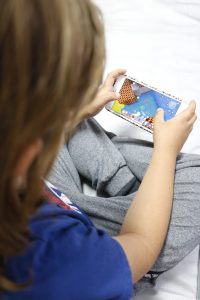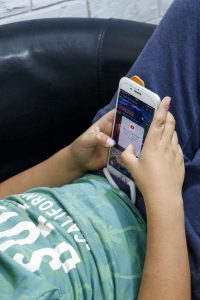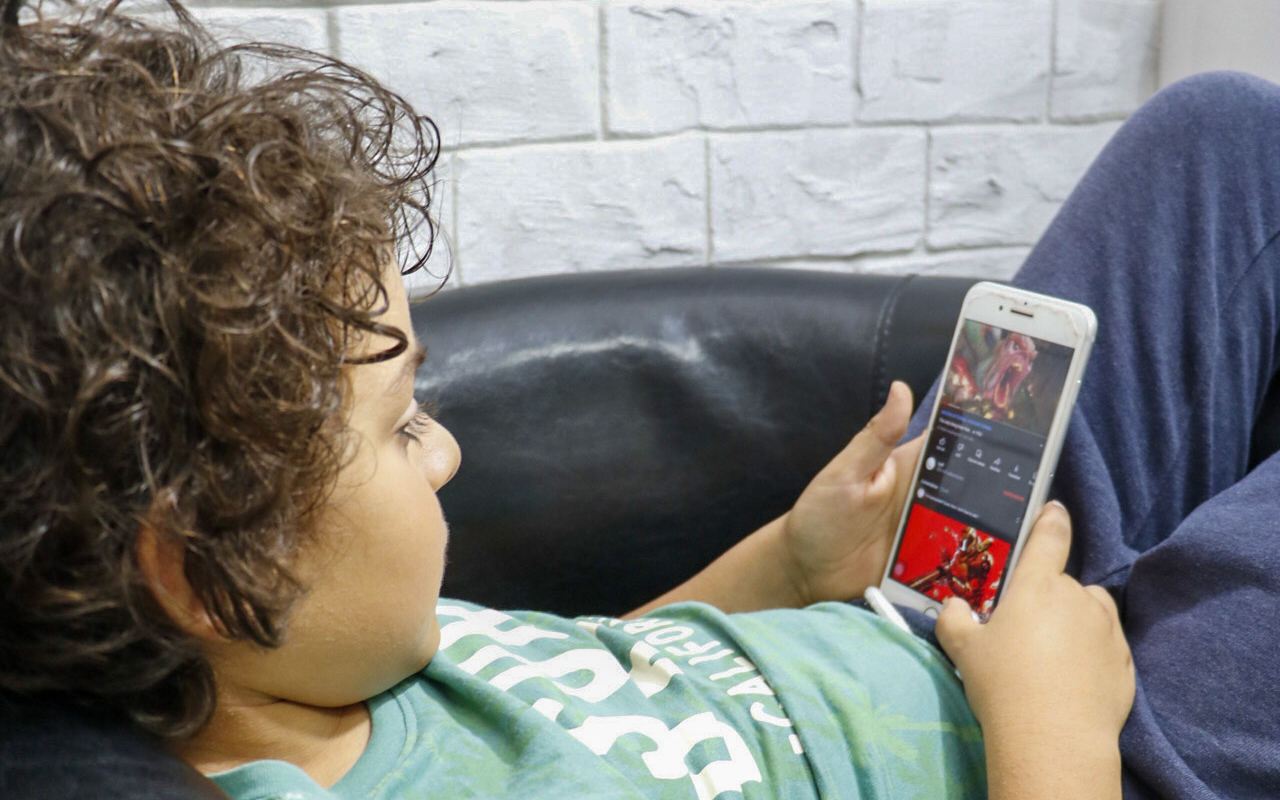 Children generally find it easier to identify pre-roll ads on YouTube as advertising but some more covert marketing tricks like unboxing, YouTubers’ recommendations and gaming videos are too complex for children to spot. For www.parenting.digital, Mariana Nascimento and Ana Jorge discuss the findings from their study with 10 Portuguese families conducted during the period of homeschooling and Covid-19 lockdown. Their findings show that children are quite susceptible to covert advertising on social media and need active support from parents to develop sufficient media literacy skills.
Children generally find it easier to identify pre-roll ads on YouTube as advertising but some more covert marketing tricks like unboxing, YouTubers’ recommendations and gaming videos are too complex for children to spot. For www.parenting.digital, Mariana Nascimento and Ana Jorge discuss the findings from their study with 10 Portuguese families conducted during the period of homeschooling and Covid-19 lockdown. Their findings show that children are quite susceptible to covert advertising on social media and need active support from parents to develop sufficient media literacy skills.
Children are increasingly attracted to digital media and YouTube is one of the social media platforms that stands out in their leisure activities. When using YouTube, children are exposed to diverse types of content and, crucially, commercial messages. Embedded within the platform, some more subtle forms of advertising are particularly difficult for children to recognise.
To develop the literacy necessary to do it, children need specific cognitive skills that can and should be stimulated. The type of parental mediation, which involves the ways in which parents teach children to deal with media content and advertising on YouTube, is crucial in the process of developing such media literacy.
Young children’s engagement with YouTube
The current generation of young children was born and raised in a highly technological environment. Digital media and platforms like YouTube form their routines from an early age and have become part of their development process. The term “digital natives” is often used to describe their intuitive use of digital media. However, being in contact with technology from an early age and being a frequent user does not necessarily mean that children are prepared to deal with what happens on digital media platforms. Children need to acquire knowledge about how to use new technologies and, mainly, develop a conscious, responsible, and critical attitude towards media messages.
To study this, we conducted research on children’s use of YouTube in the spring of 2020 during a period of homeschooling and Covid-19 lockdown. We spoke to 10 Portuguese families with children aged 8 to 12 years using parent questionnaires and interviews with the children. We also did observations of children’s use of YouTube and their interaction with different types of advertising on the platform.
We found that children’s preferences vary based on their age and gender but, similarly, they all have favourite channels, YouTubers and content types.
Minecraft. (…) It’s not just a YouTuber, it’s a group of YouTubers. Which is the Craft Family. (boy, 8 years old)
At night it’s Kinder Eggs because I find it more relaxing and while I’m not too sleepy I see LOL Surprise. (girl, 9 years old)
I really like to see a YouTuber [Sofia Oliveira] and normally (…) I always see if she publishes new videos… (girl, 11 years old)
Many parents are familiar with YouTube Kids, but few claim to use its tools. Children also know it, but don’t like to use it because they find it too restrictive or suitable for younger ages.
I don’t like it that much (…) it was because of my brother that I was forced to install (…) there are some things I like. (boy, 10 years old)
My baby brother uses… (boy, 8 years old)
It’s not my type of content, I like… not adult content (…) how can I say… teenager! (boy, 11 years old)
 Although some parents do not allow their children to access YouTube every day, the platform is an important part of the lives of all children offering opportunities for fun and distraction. Sometimes ‘going on YouTube’ comes almost as a reward when they fulfil certain duties. As children grow up, they start to have opinions about what they see online and make comparisons with what is going on in the world around them.
Although some parents do not allow their children to access YouTube every day, the platform is an important part of the lives of all children offering opportunities for fun and distraction. Sometimes ‘going on YouTube’ comes almost as a reward when they fulfil certain duties. As children grow up, they start to have opinions about what they see online and make comparisons with what is going on in the world around them.
Online exposure to marketing and advertising
Television continues to be the main channel for marketing directed to children but new digital technologies have created new forms of marketing, particularly enhanced by new media like social networks. Exposing children to marketing information on new media aims to provoke their curiosity and enable them to influence their parents’ purchasing decisions.
Some of the children we spoke to found it difficult to explain what advertising is but most associate it with ads and brands. Online advertising, which can be explicit or implicit, is often more difficult to recognize and understand than traditional forms of advertising. This can be explained by their ‘advertising literacy’ which refers to children’s skills to identify advertising, understand its messages, and differentiate commercial content from other forms of content.
People have products and for them to succeed, they present them to people through videos or… adverts! Pop-ups…! (girl, 11 years old)
All children in our research identified pre-roll ads on YouTube as advertising and the majority close them whenever possible. Only on certain occasions do children choose to watch them, for example when they like the music. When advertising is incorporated into the YouTube videos, it becomes more covert and identifying it is too complex for children. We found that:
- Unboxing videos: children start to recognize this type of advertising only from the age of 11-12 years.
I think they just want to show… the things they’ve made… this is more or less a summary of all the dolls they’ve made… They’re showing the collection! (girl, 9 years old)
It’s half advertising, half saying what’s good. (boy, 8 years old)
- YouTubers’ recommendations: it is usually older children who watch this type of content. Even when they are able to identify advertising as the mentioning of brands and showing products, children still believe YouTubers’ opinions and consider them to be genuine and honest.
They sometimes say it’s good… sometimes they say it’s bad… so I can understand if the toy is worth it or not. (girl, 10 years old)
He [Filipe Neto] is a very big influencer, so it’s usually good to know his opinion. (girl, 12 years old)
- Games’ videos: there are videos where an opinion is given about the game, but there are others where the content consists only of someone streaming the game online. In the latter case, children do not understand that they are seeing advertising.
It depends… if they are sponsoring and put the link, yeah. Otherwise, it’s not… (boy, 9 years old)
It’s about the game but it may not advertise… because he’s not praising the game, he’s just playing (…) He just played, he didn’t give his opinion. (boy, 11 years old)
Parental mediation is crucial for media literacy
 Educating and guiding children on how to use digital media safely is not an easy task and parents face many challenges. How they choose to tackle these challenges and the strategies they use – whether to restrict, control or supervise children’s internet use – make a difference to how children use YouTube.
Educating and guiding children on how to use digital media safely is not an easy task and parents face many challenges. How they choose to tackle these challenges and the strategies they use – whether to restrict, control or supervise children’s internet use – make a difference to how children use YouTube.
All parents we spoke to said that they impose restrictions in terms of time, content and locations of use and, in general, children are aware of the existence of these rules. As children grow older, parents’ restrictive measures tend to decrease and children start using the internet more autonomously. Having an older sibling also makes a difference as parents tend to adapt the rules being generally more benevolent towards the younger siblings.
They do not use the internet in their rooms and have limited hours of use (parent of an 8- year-old)
After school assignments are completed and never in the bedroom at night (parent of a 9-year-old)
He only connects to the internet when he has no duties. (parent of a 12-year-old)
In the contemporary media scene, avoiding children’s exposure to advertising is almost impossible. Restrictive mediation can limit this exposure but it can also prevent children from developing the skills needed to handle or divert advertising messages when exposed to them outside the home. A more enabling approach is better for children’s developing media literacy.
Most parents say they talk to children about YouTube experiences and advertising. However, discussing more specific issues, such as the different formats, the persuasive intent, and the recommendations of YouTubers, is uncommon. It is also rare for parents to watch videos with their children.
Sometimes my mom calls my attention because TikTok or something is on the news, but usually I’m not the one to start the conversation for that. (girl, 11 years old)
I don’t really like to talk about it. Because there are things I want to see and my parents sometimes won’t let me because they say bad words and so on. (…) But sometimes I share videos with them that I see about cooking, about cakes that I really want to make with my mom. (girl, 12 years old)
Sometimes parents are unable to help children effectively as they also struggle to understand some advertising features, such as hashtags and disclosure messages, and can ask older siblings to keep an eye on the younger ones.
Sometimes I ask his sister to be attentive (…) because she is more comfortable with the internet than I am. (parent of a boy, 9 years old)
The way forward
Communication between parents and children and shared use are essential for media literacy development. We found that parents who comment and actively explain the nature and intent of marketing advertising can help children create defence mechanisms and prevent possible negative consequences from using YouTube.
Formal media literacy education has an important role and teachers can join efforts with parents to support children better. Schools could, for example, provide parenting sessions with tools that could be applied at home or include ICT education in the curriculum from an early age.
There are also other agents such as the media, social networking platforms and children’s NGOs that could also promote media literacy and play a more active role through the promotion and development of learning activities and resources.
First published at www.parenting.digital, this post represents the views of the authors and not the position of the Parenting for a Digital Future blog, nor of the London School of Economics and Political Science.
You are free to republish the text of this article under Creative Commons licence crediting www.parenting.digital and the author of the piece. Please note that images are not included in this blanket licence.
Featured image: photo by Mariana Nascimento and Ana Jorge





